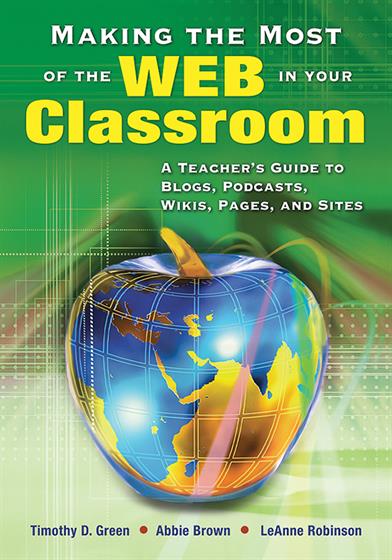Dedication
Preface & Acknowledgments
1. The Wide World of the Web: Fitting It Into the Curriculum
Guiding Questions
Key Terms
Overview
The Web and Digital Natives
Why Use the Web in the Classroom
Connecting Web Projects to National Standards
Understanding the Teaching and Learning Cycle
Enhancing Learning for All: Universal Design for Learning
Interactive Qualities of Digital Media
Flexibility for Demonstrating Learning: Multiple Pathways for Expression
Curriculum Integration Idea: Individual Web Projects
Curriculum Integration Idea: Electronic Portfolios
Engaging Students' Interest and Motivation
Developing Critical-Thinking and Information-Gathering Skills
Curriculum Integration Idea: WebQuests
Support for Cooperative Work
How Does the Use of Cooperative Learning Impact Student Achievement?
Web Tools to Enhance Students Learning
Blogs
Curriculum Integration Ideas for Blogs
Course Management/Learning Management Systems
Curriculum Integration Ideas for CMS/LMS
Instant Messaging
Curriculum Integration Ideas for Instant Messaging
Podcasts
Curriculum Integration Idea: Podcasts
RSS
Curriculum Integration Idea: RSS
Special Spaces
Wikis
Curriculum Integration Idea: Wikis
Summary
Going Beyond the Chapter
2. Using and Evaluating Web Activities and Projects in the Classroom
Guiding Questions
Key Terms
Overview
Integrating the Web Into the Curriculum: Surfing the Web (Research)
Using the Web to Send and Receive Messages
Classroom Integration Idea: Examples of Blogs by Students and Teachers
Classroom Integration Idea: Telementors
Classroom Integration Idea: Ask an Expert
Safety and Netiquette
Searching the Web: Engines and Indexes
Evaluating Web Sites
Teaching Students to Critically Evaluate Web Sites: Is the Information Valid and Reliable
Curriculum Resource: Rubric--Web Site Content Critique Form
Additional Methods for Evaluating Web Sites
Examples of Using the Web for Research in the Classroom
Curriculum Resource: Lesson Plan-- Using the Web for Research in the Elementary Classroom
Curriculum Resource: Lesson Plan-- Using the Web for Research in the Secondary Classroom
Curriculum Resource: Web Sites
Integrating the Web Into the Curriculum: Spinning the Web (Production)
The Web as a Multimedia Project: Managing Multimedia Projects in the Classroom
Curriculum Resource: Guidelines for Managing Classroom Multimedia Projects
Student-Generated Project Example Ideas
Curriculum Resource:
Lesson Plan-- Student-Generated
Web Project-- Elementary School
Curriculum Resourse:
Lesson Plan-- Student Generated
Web Project-- High School
Curriculum Integration Idea: Another Exampe of Student-Generated Web Projects
Integrating the Web Into the Curriculum: Cooperative Learning Activities
Curriculum Resource:
Lesson Plan-- High School
Using Cooperative Learning and the Web
Curriculum Resource:
Lesson Plan-- Elementary School
Using Cooperative Learning and the Web
Integrating the Web Into the Curriculum: Problem-Based Learning Activities
Curriculum Integration Idea: Web Quest
Curriculum Integration Idea: Monarch Butterfly Project
Evaluating Student-Generated Web Projects
Our Approach: Content, Product, Process
Curriculum Resource:
Rubric--Evaluation Protocols
Web Project Evalutation Rubric Examples
Curriculum Resource:
Rubric-- Web Research Project: Traditional Rubric Example
Curriculum Resource:
Rubric-- Web Project Evaluation Protocol: Student Checklist
Additional Web Resources: Taking Small Steps
Summary
Going Beyond the Chapter
3. Solving the Mystery of Designing and Creating Web Sites
Guiding Questions
Key Terms
Overview
HTML: The Language of the Web
Source Code
What Exactly is a Browser?
Making a Web Page
Naming Files
The Essential Formatting of a Web Page
Try Spinning a Web Page!
More Tags
Aligning the Elements of a Page
Formattig Text
Making Links to Other Web Pages
Adding Graphics to Web Pages
Changing the Color of the Background
The HR Tag
Putting It All Together
Web Editing Software
Viewing Web Pages: HTTP
Default Pages
Viewing Web Pages Locally
Sharing Your Web Site With the World
Sending Files to a Web Server: FTP
Finding Server Space
Commercial Server Spaces
Designing and Developing a Web Site
Step 1: Decide What the Web Site Will Do
Step 2: Decide What the Web Site Will Look Like
Step 3: Produce the Web Site
Designing With the Web's Unique Characteristics in Mind
Everybody Sees the Web a Little Differently
Choosing the Right Font
Scrolling
Links
Navigation
Layout
Summary
Going Beyond the Chapter
4. Reading Between the Lines: The Legalities and Liabilities of Using the Web in the Classroom
Guiding Questions
Key Terms
Overview
Issues of Equity
Ethnicity and Socioeconomic Issues
Gender
Disabilities
Accessing the World Wide Web
Creating Accessible Multimedia Projects
Curriculum Integration Idea: Web Accessibility Web Sites
Student Safety
Protecting Students from Inappropriate Content
Filtering Software Examples
Protecting Students from Strangers
E-mail
Instant Messaging
Chat Rooms
Groups
Message Boards/Discussion Boards
Blogs
Personal Web Pages and Classroom Web Pages
Establishing Ground Rules for Your Classroom
Netiquette
Being a Responsible User of the Web
Guidelines
Emoticons
Acronyms
Flaming
Additional Guidelines
Fair Use Guidelines
Copyright
Guidelines
Commercial Content
Summary
Going Beyond the Chapter
Resource A: The Basics of the Internet and the Web: A Refresher
Resource B: Try Spinning a Web Page! Blackline Master
References
Index




